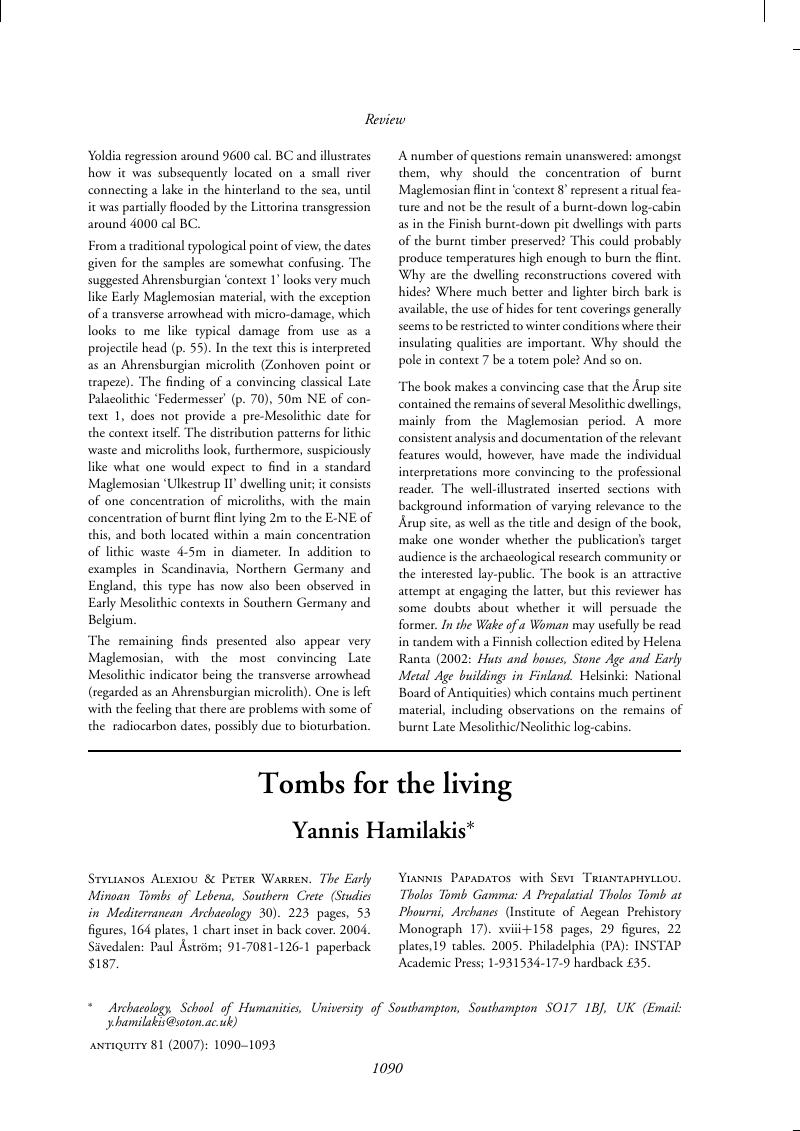No CrossRef data available.
Article contents
Tombs for the living - Stylianos Alexiou & Peter Warren The Early Minoan Tombs of Lebena, Southern Crete (Studies in Mediterranean Archaeology 30). 223 pages, 53 figures, 164 plates, 1 chart inset in back cover. 2004. Sävedalen: Paul Åström; 91-7081-126-1 paperback $187. - Yiannis Papadatos with Sevi Triantaphyllou Tholos Tomb Gamma: A Prepalatial Tholos Tomb at Phourni, Archanes (Institute of Aegean Prehistory Monograph 17). xviii+158 pages, 29 figures, 22 plates, 19 tables. 2005. Philadelphia (PA): INSTAP Academic Press; 1-931534-17-9 hardback £35.
Published online by Cambridge University Press: 02 January 2015
Abstract
An abstract is not available for this content so a preview has been provided. Please use the Get access link above for information on how to access this content.

- Type
- Review articles
- Information
- Copyright
- Copyright © Antiquity Publications Ltd. 2007
References
Blackman, D. & Branigan, K.. 1982. The excavation of an Early Minoan tholos tomb at Ayia Kyriaki Ayiofarango, southern Crete. Annual of the British School at Athens
77: 1–57.Google Scholar
Branigan, K.
1993. Dancing with Death: Life and Death in Southern Crete, c. 3000-2000 BC.
Amsterdam: A. Hakkert.Google Scholar
Hamilakis, Y.
1998. Eating the dead: mortuary feasting and the politics of memory in the Aegean Bronze Age societies, in Branigan, K. (ed.) Cemetery and Society in the Aegean Bronze Age: 115–132. Sheffield: Sheffield Academic Press.Google Scholar
Hamilakis, Y.
2002. What future for the “Minoan” past? Rethinking Minoan archaeology, in Hamilakis, Y. (ed.) Labyrinth Revisited: Rethinking “Minoan” Archaeology: 2–28. Oxford: Oxbow.Google Scholar
Karadimas, N. & Momigliano, N.. 2004. On the term “Minoan” before Sir Arthur Evans's work in Crete (1894). Studi Micenei ed Egeo Anatolici
46(2): 243–58.Google Scholar
Maggidis, C.
1998. From polis to necropolis: social ranking from architectural and mortuary evidence in the Minoan cemetery at Phourni, Archanes, in Branigan, K. (ed.) Cemetery and Society in the Aegean Bronze Age: 87–102. Sheffield: Sheffield Academic Press.Google Scholar
Michelaki, F., Branigan, K. & Campbell-Green, T.. 2006. Pottery usage in the tholos cemetery at Moni Odigitria. Paper presented at the 10th International Cretological Congress, Chania, Crete, 1-8 October 2006.Google Scholar
Panagiotopoulos, D.
2002. Das Tholosgrab E von Phourni bei Archanes. Studien zu einem frühkretischen Grabfund und seinem kulturellen Kontext (British Archaeological Report International Series 1014). Oxford: Archaeopress.Google Scholar
Papadatos, Y.
1999. Mortuary practices and their importance for the reconstruction of society and life in Prepalatial Crete: the evidence from Tholos Tomb Gamma in Archanes-Phourni. Unpublished Doctoral dissertation, Sheffield University.Google Scholar
Todaro, S.
2005. EM I-MMIA ceramic groups at Phaistos: towards the definition of a prepalatial ceramic sequence in south central Crete. Creta Antica
6: 11–46.Google Scholar
Whitley, J.
2006. The Minoans - a Welsh invention? A view from East Crete, in Hamilakis, Y. & Momigliano, N. (ed.) Archaeology and European Modernity: Producing and Consuming the “Minoans”: 55–67. Padova: Bottega d'Erasmo/Aldo Ausilio.Google Scholar




